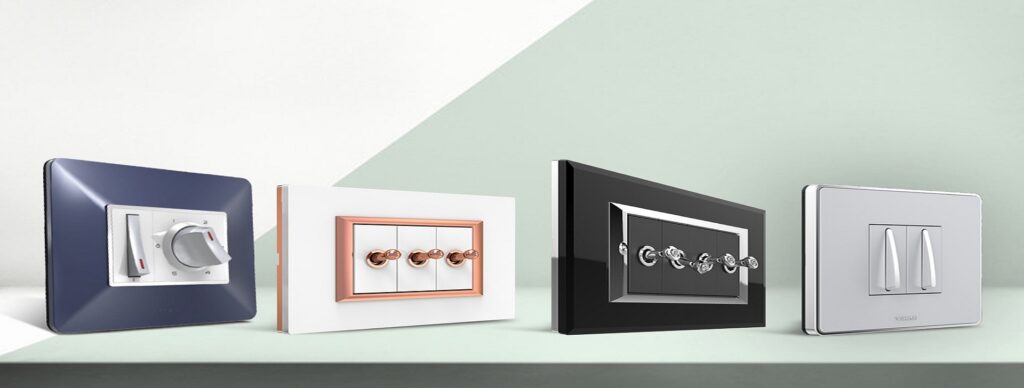
Defining an Electrical Switch
Modular switches are electrical switches that can be easily assembled and reconfigured to meet the specific needs of a particular installation. They are designed with modular components that can be easily added, removed, or replaced, allowing the switch to be customized to meet specific requirements.
Uses Of Modular Switches
Residential and commercial buildings: Modular switches are commonly used in homes, offices, and other buildings to control lighting and other electrical devices. They are available in a range of styles and designs, making it easy to find a switch that matches the décor of a particular room.
Industrial and manufacturing environments: Modular switches are used in industrial and manufacturing settings to control machinery, conveyors, and other equipment. They are typically designed to withstand harsh conditions and are available in heavy-duty versions to meet the specific needs of these environments.
Automotive and transportation: Modular switches are used in automobiles, boats, and other vehicles to control lighting, power, and other systems. They are designed to be compact, durable, and weather-resistant, making them suitable for use in mobile applications.
Medical equipment: Modular switches are used in medical equipment, such as patient monitors, infusion pumps, and ventilators, to control various functions. They are designed to be easy to operate and to meet the stringent safety requirements of the medical industry.
Consumer electronics: Modular switches are used in a wide range of consumer electronics, such as smartphones, tablet computers, and gaming devices. They are designed to be compact, reliable, and easy to operate, making them ideal for use in portable devices.
Data centers and network infrastructure: Modular switches are used in data centers and network infrastructure to control and manage data flow. They are designed to handle high-speed data transfer and to be highly scalable, making them ideal for use in complex network environments.
Military and aerospace: Modular switches are used in military and aerospace applications to control various systems, such as weapons, navigation, and communication. They are designed to meet the stringent safety and reliability requirements of these applications.
Renewable energy systems: Modular switches are used in renewable energy systems, such as solar and wind power, to control and manage the flow of electricity. They are designed to be reliable and to withstand harsh environmental conditions, making them ideal for use in renewable energy systems.
Elevators and building automation: Modular switches are used in elevators and building automation systems to control lighting, heating, ventilation, and other functions. They are designed to be easy to install and to integrate with other building systems, making them ideal for use in building automation.
Robotics and automation: Modular switches are used in robotics and automation systems to control various functions, such as movement, sensing, and power management. They are designed to be reliable and to operate in harsh conditions, making them ideal for use in robotic and automation applications.
In conclusion, modular switches are versatile and widely used in a range of applications, offering reliable and convenient control of electrical systems.
Advantages of Modular Switches:
Easy installation and maintenance: Modular switches can be easily installed and replaced, reducing the need for a skilled electrician and saving time and money on maintenance.
Cost-effective: Modular switches are less expensive than traditional switchgear and offer a cost-effective solution for both new construction and retrofitting existing buildings.
Customizable and scalable: Modular switches can be easily configured to meet specific needs, making them ideal for a wide range of applications. They can also be easily expanded or modified as needed, making them a scalable solution for growing businesses.
Improved safety: Modular switches feature safety features such as ground fault protection, over-current protection, and short-circuit protection, helping to prevent electrical accidents and fires.
Durability and reliability: Modular switches are made of high-quality materials and are built to withstand harsh environmental conditions, ensuring long-lasting performance and reliability.
Versatile design options: Modular switches come in a wide range of designs and styles, making it easy to find a solution that fits the look and feel of any space.
Improved energy efficiency: Modular switches are designed to use less energy, reducing power consumption and reducing the cost of energy bills.
Enhanced aesthetics: Modular switches offer a sleek and modern look, improving the aesthetics of any space and adding value to the building.
Increased functionality: Modular switches offer additional functionality, such as dimming, lighting control, and automation, making them a more versatile and feature-rich solution.
Compatibility with automation systems: Modular switches can be integrated with home automation systems, making it easy to control lighting, heating, and other functions from a single device.
Flexibility in reconfiguration: Modular switches can be easily reconfigured as needed, making it easy to adapt to changes in a building’s use or layout.
Standardized components for interchangeability: Modular switches use standardized components, making it easy to replace parts or upgrade the system as needed.
Reduced lead time for projects: Modular switches have a shorter lead time for projects, reducing the time and cost associated with installation and commissioning.
Improved electrical performance: Modular switches offer improved electrical performance, ensuring a stable and reliable electrical supply.
Increased energy savings: Modular switches help to reduce energy consumption, increasing energy savings and reducing environmental impact.
Reduction of cable clutter and improved cable management: Modular switches offer improved cable management, reducing cable clutter and improving the overall organization and appearance of electrical systems.
Enhanced fire resistance: Modular switches are often designed with fire-resistant materials, helping to prevent the spread of fire in the event of an electrical emergency.
Improved cable management: Modular switches often feature cable management solutions, making it easier to organize and manage electrical cables, reducing the risk of damage and enhancing the overall appearance of the electrical system.
Easy access for maintenance: Modular switches are designed for easy access, making maintenance tasks quicker and more efficient, reducing downtime and improving overall performance.
Increased availability: Modular switches can be quickly and easily replaced, increasing availability and reducing downtime in the event of a failure.
Integration with building management systems: Modular switches can be integrated with building management systems, allowing for real-time monitoring and control of electrical systems.
Improved sustainability: Modular switches are often designed with energy-saving features and are made from environmentally friendly materials, making them a more sustainable solution for electrical systems.
Better cable protection: Modular switches often feature cable protection solutions, reducing the risk of damage to electrical cables and improving the overall performance and reliability of the electrical system.
Remote control and monitoring: Modular switches can be remotely controlled and monitored, providing greater flexibility and control over lighting and other electrical systems.
Increased system efficiency: Modular switches are designed to minimize energy loss, increasing the overall efficiency of electrical systems and reducing energy waste.
Easy integration with other systems: Modular switches can be easily integrated with other electrical systems, such as lighting and HVAC systems, providing a more integrated and efficient solution.
Space-saving design: Modular switches are often designed in a compact and space-saving manner, making them ideal for use in smaller spaces or where space is limited.
Improved electromagnetic compatibility: Modular switches are designed to minimize electromagnetic interference, improving the performance and reliability of electrical systems.
Improved surge protection: Modular switches often feature improved surge protection, reducing the risk of damage to electrical equipment in the event of a surge or power outage.
What do modular switches consist of?
Modular switches typically consist of the following components:
Housing: The housing of a modular switch serves as the frame for the switch, providing support for other components and protecting against environmental factors such as dust, moisture, and temperature changes.
Modules: Modules are the individual components that make up a modular switch. They can include switches, dimmers, relays, timers, and other components that are specific to the application.
Terminals: Terminals are the connection points for electrical cables, allowing power to be supplied to the switch and connected devices.
Circuit boards: Circuit boards control the functions of the modular switch and provide a platform for the integration of additional components, such as sensors and communication modules.
Wiring: Wiring connects the different components of the modular switch, providing a path for electrical energy to flow through the system.
Cover plates: Cover plates are typically used to provide a finished appearance to the modular switch, protecting against accidental contact with electrical components, and providing an easy-to-clean surface.
Conclusion
Modular switches are a versatile and cost-effective solution for electrical switching, offering many benefits such as flexibility, easy installation, high capacity, scalability, easy maintenance, high-speed performance, Quality of Service (QoS), network management, energy efficiency, enhanced security. They are suitable for a wide range of applications, including data centers, enterprise networks, industrial automation, and telecommunications networks. When choosing a switch, it’s important to carefully consider the specific requirements of the application and weigh the advantages and disadvantages of each type of switch to make an informed decision.
